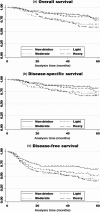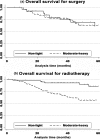Heterogeneous impact of alcohol consumption according to treatment method on survival in head and neck cancer: A prospective study
- PMID: 27801961
- PMCID: PMC5276823
- DOI: 10.1111/cas.13115
Heterogeneous impact of alcohol consumption according to treatment method on survival in head and neck cancer: A prospective study
Abstract
Alcohol consumption is an established risk factor, and also a potential prognostic factor, for squamous cell carcinoma of the head and neck (HNSCC). However, little is known about whether the prognostic impact of alcohol consumption differs by treatment method. We evaluated the association between alcohol drinking and survival by treatment method to the primary site in 427 patients with HNSCC treated between 2005 and 2013 at Aichi Cancer Center Central Hospital (Nagoya, Japan). The impact of alcohol on prognosis was measured by multivariable Cox regression analysis adjusted for established prognostic factors. Among all HNSCC patients, the overall survival rate was significantly poorer with increased levels of alcohol consumption in multivariable analysis (trend P = 0.038). Stratification by treatment method and primary site revealed that the impact of drinking was heterogeneous. Among laryngopharyngeal cancer (laryngeal, oropharyngeal, and hypopharyngeal cancer) patients receiving radiotherapy (n = 141), a significant dose-response relationship was observed (trend P = 0.034). In contrast, among laryngopharyngeal cancer patients treated with surgery (n = 80), no obvious impact of alcohol was observed. This heterogeneity in the impact of alcohol between surgery and radiotherapy was significant (for interaction, P = 0.048). Furthermore, among patients with oral cavity cancer treated by surgery, a significant impact of drinking on survival was seen with tongue cancer, but not with non-tongue oral cancer. We observed a significant inverse association between alcohol drinking and prognosis among HNSCC patients, and its impact was heterogeneous by treatment method and primary site.
Keywords: Adverse effect; alcohol; head and neck cancer; prognostic factor; treatment.
© 2016 The Authors. Cancer Science published by John Wiley & Sons Australia, Ltd on behalf of Japanese Cancer Association.
Figures


References
-
- Ferlay J, Shin HR, Bray F, Forman D, Mathers C, Parkin DM. Estimates of worldwide burden of cancer in 2008: GLOBOCAN 2008. Int J Cancer 2010; 127: 2893–917. - PubMed
-
- Cancer Registry and Statistics Cancer Information Service, National Cancer Center, Japan.
Publication types
MeSH terms
LinkOut - more resources
Full Text Sources
Other Literature Sources
Medical

